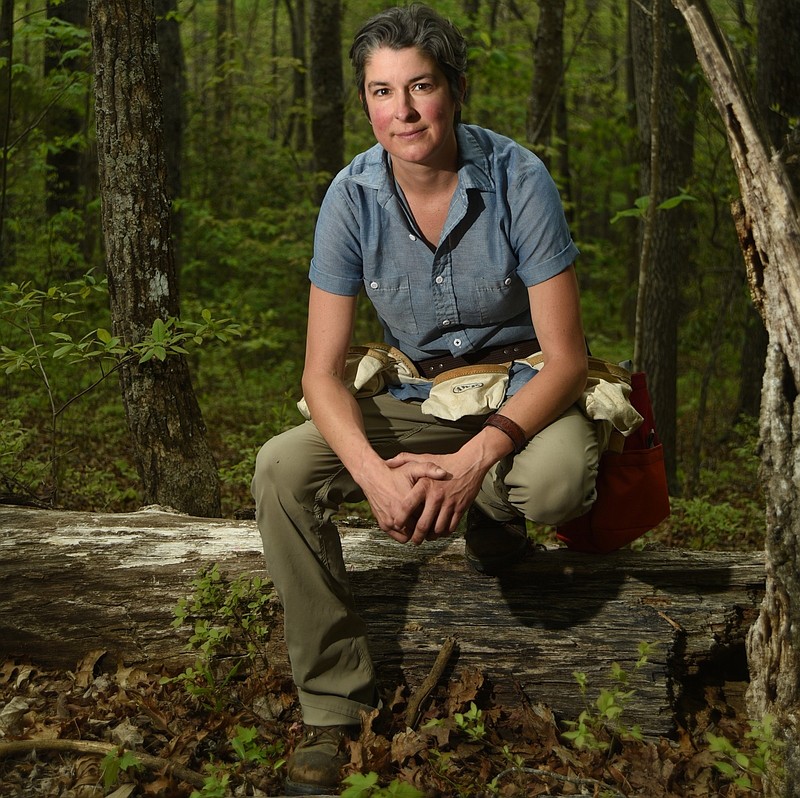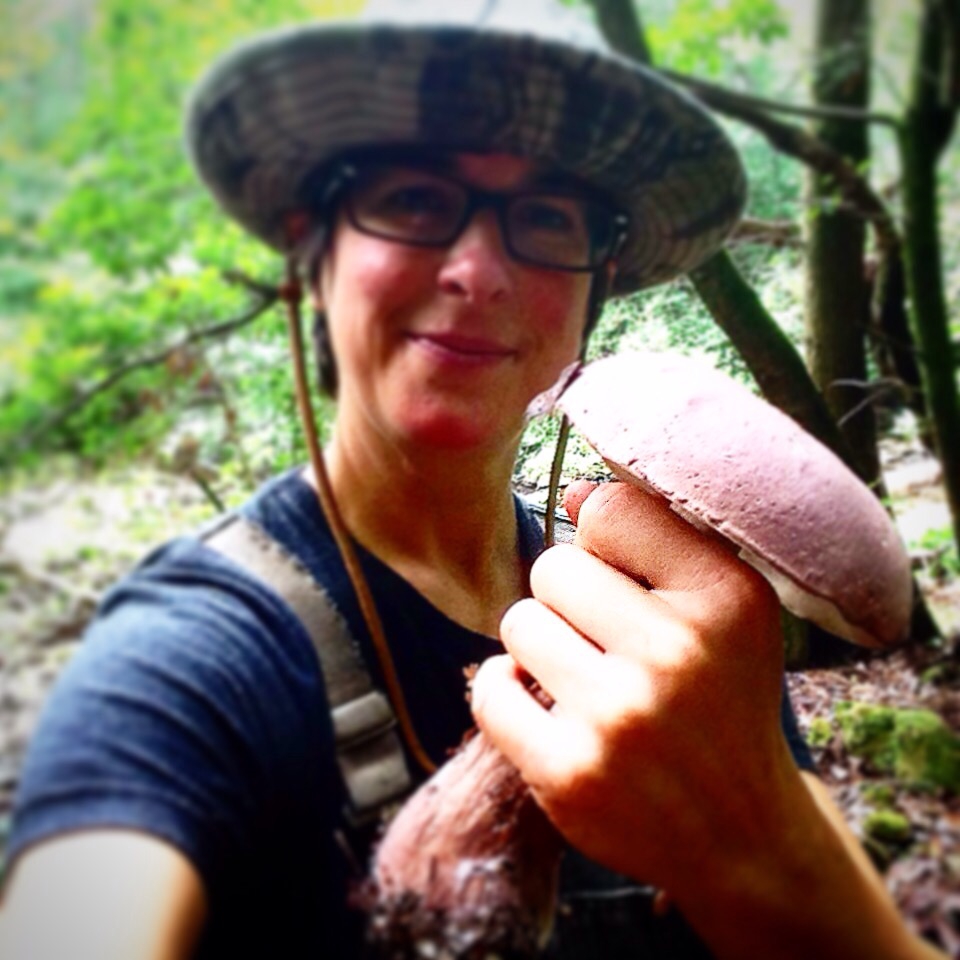When oak leaves are the size of squirrel ears, morel season has begun.
"That's what my dad taught me. He was a walking field guide," says Amy Foster, who spent her childhood in forests, learning to identify species. Like her father, Foster has developed an inherent fondness for fungus.
Growing up, Foster's family moved around a lot, living in Missouri, Nebraska, Pennsylvania and Oklahoma. Now, at age 43, Foster has settled on Signal Mountain. On a cloudy spring afternoon, she stands outside her cobblestone cabin, wearing khaki pants, a short-sleeved denim button-up and a tool belt stuffed with paper bags for mushroom collection.
"This is my poison pouch," she says, pointing to the left side of her belt. "All questionable mushrooms go here."
This time of year, nearly every day, Foster will scout her property for new growth. Some of the fruit she finds she sells to local restaurants like Cashew, Easy Bistro and St. John's. Others, she keeps for herself. But her appreciation for mushrooms stems beyond simple utility.
"[Mushrooms] fascinate me. They're beautiful. They're extremely medicinal - and delicious," Foster says.
Formerly a North Chattanooga resident, she moved to the mountain six years ago. She'd been looking for a change, she says. "I felt like I was wasting time. I wasn't being productive. It was too easy to drown my sorrows at [Aretha Frankensteins]," says Foster.
Cabin life can get lonely, she admits. But the biggest challenge to rural living has been adapting to the elements.
"The toilet froze solid one winter. I'm out of water right now because my well pump is out," she says.
Still, she feels she is finally getting back to her roots.
"I like myself better here. I can't run from anything on the mountain," Foster says.
In part, that might be due to the property's difficult terrain. Trekking pole in hand, Foster starts down the steep, rocky hillside behind her home, her sure-footed cattle dogs, Eli and Peia, bounding ahead. The rugged trail winds down a ridge and finally flattens into a creek bottom.
There, Foster pauses and points to a hemlock stump. On one end, small white buttons protrude. Reishi mushrooms, she says. "When they're ripe, they look like E.T.'s head. They're called the 'immortal mushroom.'"
Reishi is considered by natural healers to be one of the most potent mushrooms in the world. Foster will use it to brew a tincture, a medicine made by dissolving a substance in alcohol. Other mushrooms, like morels, she might simply sauté with butter in an iron skillet.
The fungi she finds and their functions run the gamut. Here are a few of her favorites:
Chicken of the woods
(Laetiporus sulphureus)
Chicken of the woods is most beloved for its meaty, chicken-like flavor. The last batch Foster harvested, she sold to Cashew, a vegan café formerly on the North Shore, which used it for "chicken-of-the-woods Waldorf salad." More than taste, Foster says she appreciates this fungus because it helps treat her tendinitis.
Medicinal uses: While there is no hard evidence to support that chicken of the woods relieves inflammation, the mushroom does have some proven health benefits. Namely, it is rich in antioxidants and contains lanostanoids, which are molecules that can help prevent cancer. Chicken of the woods is also high in protein and low in fat and calories.
Reishi Mushroom
(Ganoderma lucidum)
Once harvested, Foster will finely chop this mushroom, boil it and then soak it in vodka for a minimum of three months to produce a tincture. Then, she will add a dropper-full a day to tea or juice, which, she says, benefits her overall wellness.
Medicinal uses: Some studies have shown the reishi mushroom to stimulate the immune system, lower high cholesterol and high blood pressure, reduce inflammation, reverse liver damage, prevent cancer and treat diseases such as HIV/AIDS, Alzheimer's and Huntington's. Purported benefits include increased strength and stamina and extended life.
Turkey Tail
(Trametes versicolor)
One of the most common mushrooms in North American forests, turkey tail thrives on dead hardwood stumps. When Foster harvests a batch, she likes to boil it into a broth, then add it to soups. She says the mushroom has a strong earthy odor and pairs well with beef.
Medicinal uses: Turkey tail is most touted for its ability to strengthen the immune system. In fact, turkey tail tablets are available at places like Whole Foods and Earth Fare. Furthermore, clinical studies in Asia have shown the fungus to especially benefit cancer patients. When paired with conventional cancer treatments, it helped significantly lengthen lifespan.
Lion's mane mushroom
(Hericium erinaceus)
The lion's mane mushroom is one of Foster's favorites. Instead of gills beneath its cap, it has long, thin, vertical "teeth" - which make it ideal for deep-frying, says Foster. "Those teeth just hold all that batter. Put a little Cajun seasoning on it Oh, it's delicious," she says.
Medicinal uses: Delectability aside, lion's mane is becoming increasingly more popular for its potential benefit to brain function. While research is still being conducted, the mushroom is believed to boost memory, focus and concentration. In fact, in one study, it was shown to treat Alzheimer's symptoms in lab rats.
"It's like a pharmacy out here," Foster says of the forest. But, she adds, she is no mushroom expert. She is still learning.
"A friend once said to me, 'Amy, it's a good day when you learn something and a bad day when you don't,'" says Foster.
When she discovers a mushroom she cannot ID, Foster will tuck a sample into her pouch. Back at her cabin, she will read online forums, study field guides, confer with her mentors and conduct spore prints, which is when a mushroom cap is placed on paper, allowing the spores to fall in an identifiable pattern.
One of the coolest facts about fungi, says Foster, is that spores are literally everywhere - microscopic mushroom seeds swirling through the air, waiting for the right place to land before they can flourish.

